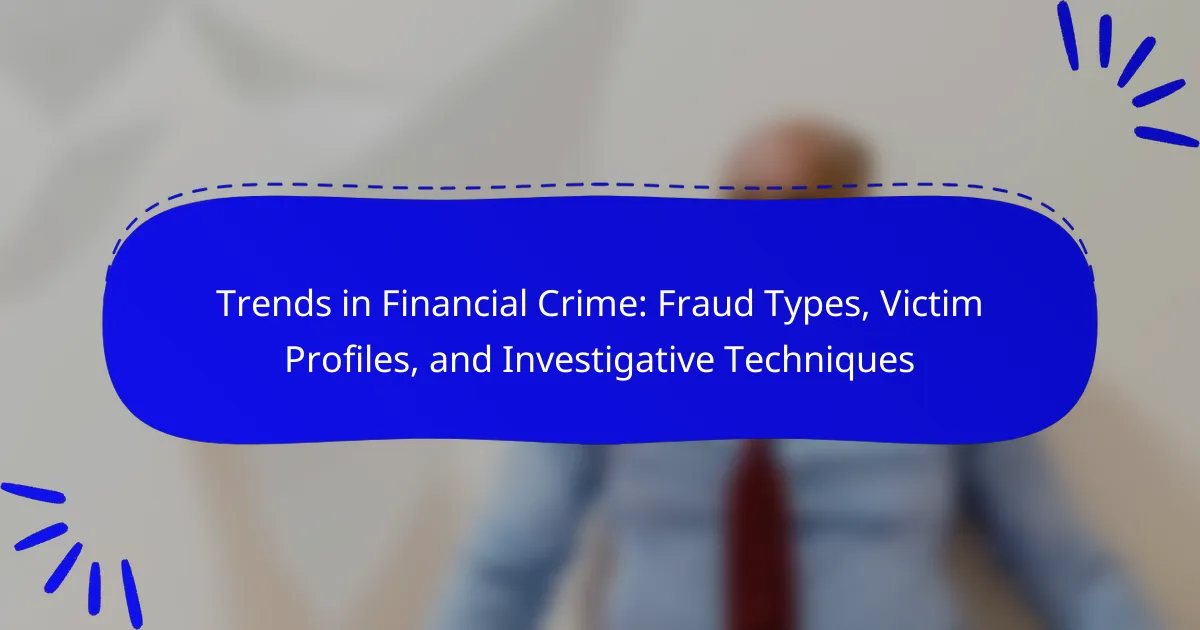
What are the current trends in financial crime?
Current trends in financial crime include an increase in cybercrime, particularly phishing schemes. These schemes exploit vulnerabilities in digital communication to steal sensitive information. According to the FBI’s Internet Crime Complaint Center, losses from phishing attacks exceeded $54 million in 2022. Additionally, identity theft remains prevalent, with over 1.4 million reports filed in 2021. Cryptocurrency-related fraud is also on the rise, accounting for nearly $14 billion in losses in 2021. Furthermore, money laundering techniques are evolving, utilizing digital currencies to obscure transaction trails. The rise of remote work has created new opportunities for fraud, as employees face increased phishing attempts. These trends highlight the need for enhanced cybersecurity measures and regulatory frameworks.
How has financial crime evolved in recent years?
Financial crime has evolved significantly in recent years. Cybercrime has become the dominant form of financial crime. Fraud schemes have increasingly utilized advanced technology. Phishing attacks and ransomware incidents have surged, targeting individuals and businesses alike. According to the FBI’s Internet Crime Complaint Center, reported losses from internet crimes exceeded $4.2 billion in 2020. Cryptocurrency has also introduced new vulnerabilities, facilitating anonymous transactions. Regulatory scrutiny has intensified, leading to stricter compliance requirements for financial institutions. Overall, the landscape of financial crime is more complex and technology-driven than ever before.
What factors contribute to the rise of financial crime?
Economic instability contributes to the rise of financial crime. During economic downturns, individuals may resort to illegal activities for survival. Increased unemployment rates lead to desperation and potential criminal behavior. The advancement of technology also plays a significant role. Cybercrime has surged with the rise of online banking and digital transactions. Weak regulatory frameworks can enable financial crime to flourish. Insufficient oversight allows illicit activities to go undetected. Additionally, globalization has made it easier for criminals to operate across borders. The interconnectedness of economies can complicate enforcement efforts. Finally, social factors such as corruption can further exacerbate financial crime rates. High levels of corruption undermine trust in financial systems, making fraud more likely.
How do technological advancements impact financial crime trends?
Technological advancements significantly impact financial crime trends by facilitating new methods for committing fraud. Innovations such as online banking and cryptocurrency have increased opportunities for cybercriminals. For instance, the rise of phishing attacks exploits advancements in communication technology. According to the FBI’s Internet Crime Complaint Center, losses from phishing schemes exceeded $54 million in 2020. Additionally, the use of artificial intelligence in fraud detection has become crucial. However, criminals also employ AI to create sophisticated scams. Research by the Association of Certified Fraud Examiners highlights that technology-driven fraud schemes are on the rise. Thus, while technology aids in prevention, it simultaneously provides avenues for financial crime evolution.
What types of fraud are most prevalent today?
Identity theft, credit card fraud, and online scams are the most prevalent types of fraud today. Identity theft occurs when personal information is stolen to impersonate someone else. According to the Federal Trade Commission, identity theft reports increased by 113% from 2019 to 2020. Credit card fraud involves unauthorized use of someone’s credit card information for purchases. The Nilson Report indicates that global card fraud losses reached $28.65 billion in 2019. Online scams, including phishing and advance-fee fraud, exploit victims through deceptive emails or websites. The FBI’s Internet Crime Complaint Center reported over 300,000 complaints related to online scams in 2020. These statistics highlight the significant rise in various fraud types in recent years.
What are the characteristics of common fraud types?
Common fraud types exhibit distinct characteristics. These include deception, financial gain, and victim targeting. Deception involves misleading information or false representations. Financial gain is the primary motive behind most fraud schemes. Victim targeting often focuses on individuals or organizations perceived as vulnerable. Additionally, common fraud types can be categorized into specific forms, such as identity theft, credit card fraud, and phishing. Identity theft involves stealing personal information for unauthorized transactions. Credit card fraud entails unauthorized use of credit card details. Phishing uses deceptive emails to trick individuals into providing sensitive information. Each fraud type relies on manipulation and exploitation of trust.
How do different fraud types affect various sectors?
Different fraud types impact various sectors in distinct ways. For instance, credit card fraud primarily affects the retail and banking sectors. In 2022, the retail sector lost approximately $24 billion due to credit card fraud. Insurance fraud significantly burdens the insurance industry, costing it around $80 billion annually. Healthcare fraud affects the medical sector, with an estimated $68 billion lost each year in fraudulent claims. Cyber fraud impacts technology and finance sectors, with global losses reaching $1 trillion in 2020. These financial repercussions highlight how fraud types uniquely challenge and strain specific industries.

Who are the typical victims of financial crime?
Typical victims of financial crime include individuals, businesses, and government entities. Individuals often fall victim to identity theft and credit card fraud. Businesses may be targeted through corporate fraud and phishing schemes. Government entities can experience tax fraud and procurement fraud. According to the Association of Certified Fraud Examiners, individuals aged 30 to 50 are frequently affected. Vulnerable populations, such as the elderly, are also common targets due to their limited financial literacy. The Federal Trade Commission reported that in 2020, consumers lost over $3.3 billion to fraud, highlighting the widespread impact on various victim profiles.
What demographics are most affected by financial fraud?
Older adults are most affected by financial fraud. Research indicates that individuals aged 60 and above are targeted frequently. This demographic often faces cognitive decline, making them vulnerable to scams. Additionally, they may have accumulated savings, attracting fraudsters. Women in this age group report higher instances of fraud victimization. Low-income individuals also experience significant impacts from financial fraud. They may lack resources to recover from losses. Furthermore, individuals with limited financial literacy are at greater risk. They may not recognize fraudulent schemes or understand warning signs.
How does age influence vulnerability to financial crime?
Age influences vulnerability to financial crime significantly. Older adults often face higher risks due to factors like decreased cognitive function and social isolation. According to the FBI, individuals over 60 are frequently targeted in scams, resulting in substantial financial losses. Younger individuals may also be at risk, primarily through online fraud, as they often engage more with digital platforms. Research from the Federal Trade Commission indicates that younger adults report higher incidences of identity theft. Overall, age shapes the types of financial crimes individuals may encounter and their susceptibility to them.
What role does socioeconomic status play in victim profiles?
Socioeconomic status significantly influences victim profiles in financial crime. Individuals from lower socioeconomic backgrounds are often more vulnerable to fraud. Limited financial literacy can lead to poor decision-making. Economic stress may increase desperation, making them targets for scams. Higher-income individuals may have more resources to recover from fraud. Studies show that socioeconomic factors correlate with victimization rates. For instance, a report by the Federal Trade Commission indicates that low-income individuals report higher instances of fraud. This pattern underscores the importance of addressing socioeconomic disparities in fraud prevention efforts.
What psychological factors contribute to victimization?
Psychological factors that contribute to victimization include low self-esteem, social isolation, and a lack of assertiveness. Individuals with low self-esteem may feel unworthy and thus more susceptible to manipulation. Social isolation can lead to a lack of support systems, making individuals more vulnerable. A lack of assertiveness may prevent individuals from standing up to aggressive or fraudulent behavior. Research indicates that these psychological traits can increase the likelihood of becoming a victim of financial crimes. For example, a study by the National Institute of Justice found that victims often exhibit characteristics such as high anxiety and low confidence, which can be exploited by fraudsters.
How do trust and naivety impact susceptibility to fraud?
Trust and naivety significantly increase susceptibility to fraud. Individuals with high trust levels are more likely to believe in fraudulent schemes. Naive individuals often lack the experience to recognize warning signs of fraud. This combination makes them easy targets for scammers. Research shows that 70% of fraud victims report trusting the perpetrator. Fraudsters exploit this trust to manipulate victims into compliance. Naivety can lead to inadequate scrutiny of offers that seem too good to be true. Consequently, both trust and naivety create vulnerabilities that fraudsters can easily exploit.
What emotional consequences do victims face after fraud?
Victims of fraud often experience significant emotional consequences. Common feelings include anxiety, fear, and depression. Many victims report a loss of trust in others. This can lead to social withdrawal and isolation. Victims may also feel shame or embarrassment about being deceived. These emotional impacts can affect daily functioning and relationships. Research shows that fraud victims often experience post-traumatic stress symptoms. According to a study published in the Journal of Financial Crime, 30% of fraud victims reported long-term psychological distress. This highlights the profound emotional toll fraud can take on individuals.

What investigative techniques are used to combat financial crime?
Investigative techniques used to combat financial crime include forensic accounting, data analytics, and surveillance. Forensic accounting involves examining financial records to uncover discrepancies. Data analytics utilizes software to detect unusual patterns in transactions. Surveillance helps gather evidence by monitoring suspect activities. Additionally, interviews with witnesses and suspects can provide crucial information. Collaboration with law enforcement agencies enhances the effectiveness of these techniques. These methods are supported by successful case outcomes, such as the recovery of millions in embezzled funds.
How do law enforcement agencies investigate financial fraud?
Law enforcement agencies investigate financial fraud through a systematic approach. They begin by gathering evidence related to the suspected fraud. This involves reviewing financial records, transaction histories, and communication logs. Agencies often collaborate with financial institutions to obtain necessary data. They also interview victims and witnesses to gather additional information. Surveillance may be used to track suspects involved in fraudulent activities. Forensic accountants are frequently employed to analyze complex financial transactions. Data analytics tools assist in identifying patterns and anomalies in financial behavior. These methods collectively enhance the investigation’s effectiveness and accuracy.
What tools and technologies are utilized in financial crime investigations?
Financial crime investigations utilize various tools and technologies to detect and prevent illicit activities. Key tools include data analytics software that analyzes transaction patterns for anomalies. These software solutions often employ machine learning algorithms to enhance detection capabilities. Additionally, forensic accounting tools help trace financial transactions and identify fraudulent activities. Surveillance technologies, such as video monitoring, support investigations by providing visual evidence. Blockchain analysis tools are increasingly used to track cryptocurrency transactions and uncover illicit uses. Furthermore, case management systems streamline investigative processes by organizing information and facilitating collaboration among investigators. Lastly, artificial intelligence enhances predictive analytics, enabling proactive measures against potential financial crimes.
How do collaboration and information sharing enhance investigations?
Collaboration and information sharing enhance investigations by improving access to diverse data sources. This leads to a more comprehensive understanding of cases. Multiple agencies can pool resources and expertise. This collective effort can identify patterns that may not be visible to a single entity. For instance, sharing intelligence can reveal connections between seemingly unrelated incidents. Research indicates that collaborative investigations can increase case resolution rates by up to 30%. Improved communication also fosters trust among stakeholders, facilitating quicker responses to emerging threats. Overall, these practices result in more effective and efficient investigations.
What best practices can organizations adopt to prevent financial crime?
Organizations can adopt several best practices to prevent financial crime. Implementing robust internal controls is essential. This includes segregation of duties to minimize fraud risks. Regular audits help identify discrepancies and reinforce accountability. Training employees on recognizing red flags is crucial. Awareness programs can enhance vigilance against financial crime. Utilizing advanced technology for transaction monitoring can detect suspicious activities. Establishing a whistleblower policy encourages reporting of unethical behavior. Compliance with regulations and standards, such as AML laws, is necessary to mitigate risks. These practices collectively strengthen an organization’s defenses against financial crime.
How can employee training mitigate the risk of fraud?
Employee training can mitigate the risk of fraud by enhancing awareness and understanding of fraudulent activities. Training programs educate employees about different types of fraud and red flags to recognize. This knowledge empowers employees to identify suspicious behavior early. Regular training sessions reinforce the importance of ethical behavior and compliance with company policies. According to the Association of Certified Fraud Examiners, organizations with fraud training programs experience 50% less fraud loss. Additionally, trained employees are more likely to report suspicious activities promptly. Overall, effective training creates a culture of vigilance against fraud within the organization.
What role does technology play in fraud prevention strategies?
Technology is essential in fraud prevention strategies. It enhances the ability to detect and mitigate fraudulent activities. Advanced algorithms analyze transaction patterns in real-time. Machine learning models identify anomalies that suggest fraud. Data analytics enables organizations to assess risk more effectively. Automated systems streamline the reporting and investigation processes. Cybersecurity measures protect sensitive information from breaches. According to a report by the Association of Certified Fraud Examiners, technology adoption can reduce fraud losses by up to 50%.
The main entity of the article is financial crime, which encompasses various fraud types, victim profiles, and investigative techniques. The article outlines current trends in financial crime, highlighting the rise of cybercrime, identity theft, and cryptocurrency-related fraud, along with the evolving methods used by criminals. It examines the characteristics of prevalent fraud types, the demographics most affected, and the psychological factors contributing to victimization. Additionally, the article discusses investigative techniques employed by law enforcement and best practices organizations can adopt to prevent financial crime, emphasizing the critical role of technology and training in mitigating risks.
